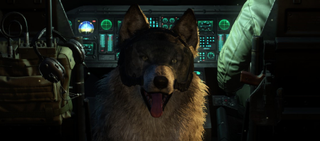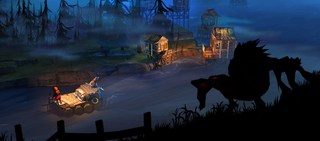
THE LOWS
Evan Lahti: VR blues
It’s frustrating that we’re still mostly talking about VR as a piece of hardware. Maybe I’m just being impatient. I was griping to Wes about this in the car this week before he flew out to cover Oculus Connect for us. It feels like we’ve spent the last three years talking about how exciting VR is in terms of its technology as it’s iterated over time—as an editor, that’s almost exclusively what’s been written about, and what we’ve had to work with. But as a PC gamer, I’m disappointed that we don’t really have games that aren’t either ports or proverbial toe-dips in the pool of VR’s potential. Where’s the killer app?
I fully respect that developing an ambitious VR game at this stage is an insane proposition: you’re setting yourself up to spend millions pioneering something for a microscopic audience. But that sort of life-changing experience is necessary to woo average gamers: you need a game that goes far beyond being a tech demo and evangelizes the hardware itself. It’s great to hear that Oculus is invested in helping developers succeed, but I think the work of convincing gamers and the larger public that VR is something you must own is yet to be done.
Samuel Roberts: Absent assassin
I share Phil’s view that more Hitman at launch is probably a good idea—going out into this Steam Early Access-style program with bare bones of levels and stuff to do could lead to a lot of people writing it off straight away, so it’s important that IO gets this right. I am disappointed because it was one of the five best things I saw at E3, though, and I was looking forward to sampling it this year and watching it grow into a full game over the course of 2016.
Nonetheless, I’ll have to wait until March to see if this really is the return to sandbox gameplay for the Hitman series as the early footage promises. I’m about a third of the way into replaying Hitman 2 and even in its relatively rough, ageing state, you can see how that style of game led to Metal Gear Solid V’s sandbox design. I’d love to see IO to bring that type of game up to date.

Andy Kelly: Snake charmer
I finished Metal Gear Solid V this week. Don’t worry, I won’t spoil anything. Overall, it was a joyous 70 hours, and probably the best stealth game I’ve ever played. But the Metal Gear Solid fan in me couldn’t help but be disappointed. Not with the ending—which many have declared to be either shit, unfinished, or both—but with the total lack of character development.
I’m that guy who loves the codec conversations in Metal Gear games. Kojima has always been great at creating richly-painted characters who go on emotional journeys, and who change throughout the course of the game. But I felt none of that in V—even after listening to all the cassette tapes. The characters were strangely one-dimensional. Snake barely speaks. Skull Face is no more complex than a Bond villain. This is not what I was expecting.
All of the bosses in previous games had backstories that explained their villainy. You even sympathised with some of them, and felt guilty for killing them. I really missed that in V. But I have a positive spin on it. Instead of writing a dramatic, epic story like before, Kojima has, instead, given us the tools to make our own in his absence. He won’t be writing any more tales about the legendary Big Boss, but we can keep creating them in that fantastic sandbox.
The biggest gaming news, reviews and hardware deals
Keep up to date with the most important stories and the best deals, as picked by the PC Gamer team.
Phil Savage: No more news
Forgive the self-indulgence, but I have a new job! With Chris now heading up the excellent PC Gamer Pro, I've moved into his former role as PC Gamer's deputy editor. This, naturally, is not really a low. But I will miss that, across my three years as PC Gamer's news writer, I've been allowed to post stick-man interpretations of Just Cause 2 screenshots, fill every Witcher 3 story with increasingly demented variations on Geralt in the bath, and, for reasons that I still can't fully explain, make Stoat puns.
Gaming news sometimes veers a little too much towards serious business for my tastes. There are times when that's absolutely needed, but it's good to be reminded that this is a hobby predicated on fun, on creativity, on self-expression, and often on a little bit of silliness. I like to think PC Gamer has—and will continue to be—an entertaining way to catch up on the day's happenings. Thanks to everyone who's been reading our news coverage over the last three years I've helped to write it.
(There are, of course, plenty of things I won't miss. Like having to care about Ubisoft's daily ALL-CAPS 5pm press releases. Or sifting through the roughly seven-billion new Kickstarter pitches I get sent every week. Or the absurd number of requests I get asking if I'd like to cover some new iPhone game. Seriously, developers, stop asking us to cover your iPhone games.)

Chris Livingston: Eat 'n greet
Someone recently wrote a handy guide to how survival games, especially those in Early Access, get hunger and thirst wrong. Oh, right, it was me. The Flame in the Flood has just entered Early Access, and I feel like it's a good example of most of the points I made. Hunger and thirst meters dwindle at just about the same speed, which gives them the same importance, and I feel like thirst should be far more pressing than hunger. The meters also drain fairly rapidly, meaning you're spending most of your time finding, preparing, and eating or drinking, which makes the game feel like a kitchen simulator, and leaves less time for other things, like crafting or exploring.
Obviously, eating and drinking should be a challenge. I'm not saying there should be a fresh-baked pie waiting on every dock, or that weeks should pass before you get a bit peckish. But I still think upon entering Early Access, it's better to aim hunger and thirst toward the forgiving side of the spectrum. Leave new players enough time to really take in your game, see what it's about, see what there is to do, instead of forcing them to race full speed through the game, eyes scanning at all times for groceries that need to be immediately crammed into their mouths.
James Davenport: Whale Train
This week at the Oculus Connect 2 developer conference some footage of a new VR tech demo named Bullet Train debuted. And good god, it looks boring. I enjoy shooting bad guys in their face from time to time, so long as it’s framed appropriately and played via mouse clicks. It’s no surprise that FPS games emerged from input devices like the mouse and keyboard. Using a mouse and keyboard to move around a cursor to specific points under pressure makes sense. It’s a natural form of design to emerge from how we’ve grown to interact with computers.
VR is a completely different input/output combo device though. While mice are often an emulation of arm movement unnaturally tied to sightlines, VR’s primary input is where you’re looking based on neck movement. Sure, throw in the touch controllers and you can conceivably make a shooter. I’m not saying Bullet Train shouldn’t exist, I’d just like to see new design archetypes emerge with the Rift’s primary inputs in mind. I find it disheartening to see Bullet Train featured so prominently. I guess the idea is for it to be connective tissue for folks that have yet to try VR themselves. It’s easy to see a shooting game and understand what’s going on, but it’s also the least interesting creative avenue VR can offer. This is just a long winded way of pitching my new VR game, WhaleTime, where you just swim around as a whale. Call me, Palmer.
PC Gamer is the global authority on PC games—starting in 1993 with the magazine, and then in 2010 with this website you're currently reading. We have writers across the US, Canada, UK and Australia, who you can read about here.
Most Popular


